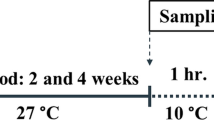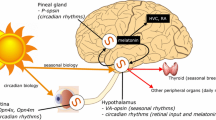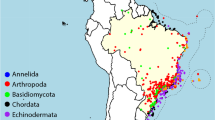Abstract
To study the relevance of density and background color to stress response, appetite, and growth in olive flounder, Paralichthys olivaceus, we reared two duplicate groups of juveniles (total length 4.46 ± 0.06 cm, body weight 0.77 ± 0.03 g) in flat-bottom aquaria with dark-green (control) and white backgrounds for 120 days. We measured cortisol and glucose levels in blood and calculated the daily food intake, food conversion efficiency, survival rate, and growth rate. To study the relevance of density and background color to malpigmentation (hypermelanosis) on the blind side, we also compared malpigmented ratios and prepro-melanin-concentrating hormone mRNA activities in the brain between the dark-green and white background groups, as well as between a relatively lower density (60 days) and higher density (120 days). Although we measured relatively higher levels of cortisol and glucose in the white background group and over 200 % of coverage area [PCA]), the bright background failed to induce an acute stress response of more than 20 ng/ml cortisol and 40 mg/dl glucose both in 60 days and 120 days, but did enhance appetite and growth. Also, a bright background color delayed hyperpigmentation only at a low density below 200 % PCA, but did not inhibit malpigmentation at a high density of more than 200 % PCA. In addition, below 200 % PCA, expression of MCH mRNA was significantly higher in the white group, but the level was reversed and was lower in the white group at more than 200 % PCA. In conclusion, although did not induce a high stress response over 200 % PCA, the bright background color resulted in a moderate increasing of cortisol level in blood below 20 ng/ml and enhanced appetite and growth. Moreover, at a density below 200 % PCA, the bright color inhibited hypermelanosis with high MCH mRNA activity, but at more than 200 % PCA did not inhibit malpigmentation, and the fish showed low MCH mRNA activity, indicating that the inhibitory effect of a bright background color on hypermelanosis is density dependent.





Similar content being viewed by others
References
Abbott CR, Kennedy AR, Wren AM, Rossi M, Murphy KG, Seal LJ (2003) Identification of hypothalamic nuclei involved in the orexigenic effect of melanin-concentrating hormone. Endocrinology 44:3943–3949
Amiya N, Amano M, Takahashi A, Yamanome T, Kawauchi H, Yamamori K (2005) Effects of tank color on melanin-concentrating hormone levels in the brain, pituitary gland and plasma of the barfin flounder as revealed by a newly developed time-resolved fluoroimmunoassay. Gen Comp Endocrinol 143:252–256
Amiya N, Amano M, Yamanome T, Yamamori K, Takahashi A (2008) Effects of background color on GnRH and MCH levels in the barfin flounder brain. Gen Comp Endocrinol 155:88–93
Baker BI (1993) The role of melanin-concentrating hormone in colour change. Ann NY Acad Sci 680:279–289
Barcellos LJG, Kreutz LC, Quevedo RM, da Rosa JGS, Koakoski G, Centenaro L, Pottker E (2009) Influence of color background and shelter availability on jundiá (Rhamdia quelen) stress response. Aquaculture 288:51–56
Berman JR, Skarish G, Maro GS, Mignot E, Mourraini P (2009) Characterization of two melanin-concentrating hormone genes in zebrafish reveals evolutionary and physiological links with the mammalian MCH system. J Comp Neurol 517:695–710
Bernier NJ, Bedard N, Peter RE (2004) Effects of cortisol on food intake, growth, and forebrain neuropeptide Y and corticotropin-releasing factor gene expression in goldfish. Gen Com Endocrinol 135:230–240
Bird DJ, Potter IC, Sower SA, Baker BI (2001) The distribution of melanin concentrating hormone in the lamprey brain. Gen Comp Endocrinol 121:232–241
Bolker JA, Hill CR (2000) Pigmentation development in hatchery-reared flatfishes. J Fish Biol 56:1029–1052
Bonga SEW (1997) The stress response in fish. Physiol Rev 77:591–625
Cavagnini F, Croci M, Putignano P, Petroni ML, Invitti C (2000) Glucocorticoids and neuroendocrine function. Int J Obes 24:S77–S79
De Boeck G, Alsop D, Wood C (2001) Cortisol effects on aerobic and anaerobic metabolism, nitrogen excretion, and whole-body composition in juvenile rainbow trout. Physiol Biochem Zool 74:858–868
Della-Zuana O, Presse F, Ortola C, Duhault J, Nahon JL, Levens N (2002) Acute and chronic administration of melanin-concentrating hormone enhances food intake and body weight in Wistar and Sprague-Dawley rats. Int J Obes Relat Metab Disord 26:1289–1295
Doolan BJ, Booth MA, Jones PL, Allan GL (2007) Effect of cage colour and light environment on the skin colour of Australian snapper Pagrus auratus (Bloch, Schneider, 1801). Aquac Res 38:1395–1403
Doolan BJ, Booth MA, Allan GL, Jones PL (2009) Changes in skin colour and cortisol response of Australian snapper Pagrus auratus (Bloch, Schneider, 1801) to different background colours. Aquac Res 40:542–550
Farbridge KJ, Leatherland JF (1992) Plasma growth hormone levels in fed and fasted rainbow trout (Oncorhynchus mykiss) are decreased following handling stress. Fish Physiol Biochem 10:67–73
Foo JTW, Lam TJ (1993) Serum cortisol response to handling stress and the effect of cortisol implantation on testosterone level in the tilapia Oreochromis mossambicus. Aquaculture 115:145–158
Fujii R (2000) The regulation of motile activity in fish chromatophores. Pigment Cell Res 13:300–319
Gröneveld D, Eckhardt ER, Coenen AJ, Martens GJ, Balm PH, Wendelaar Bonga SE (1995) Expression of tilapia prepromelanin-concentrating hormone mRNA in hypothalamic and neurohypophysial cells. J Mol Endocrinol 14:199–207
Haga Y, Takeuchi T, Seikai T (2002) Influence of all-trans retinoic acid on pigmentation and skeletal formation in larval Japanese flounder. Fish Sci 68:560–570
Ito M, Gomori A, Ishihara A, Ito M, Mashiko S, Matsushita H (2003) Chronic intracerebro-ventricular infusion of MCH causes obesity in mice. Am J Physiol Endocrinol Metab 284:E583–E588
Iwata N, Kikuchi K (1998) Effect of sandy substrate and light on hypermelanosis of the blind side in cultured Japanese flounder, Paralichthys olivaceus. Environ Biol Fish 52:291–297
Kang DY, Kim HC, Chang YJ (2011) Effects of stocking density on the blind-side hypermelanosis of cultured flounder, Paralichthys olivaceus. Fish Aquat Sci 14:135–141
Kauffman AS, Rissman EF (2004) The evolutionarily conserved gonadotropin-releasing hormone II modifies food intake. Endocrinology 145:686–691
Kawauchi H (1989) Melanin concentrating hormone II structure and biosynthesis of melanin-concentrating hormone. Life Sci 45:1133–1140
Kawauchi H (2006) Functions of melanin-concentrating hormone in fish. J Exp Zool 305A:751–760
Kawauchi H, Baker BI (2004) Melanin-concentrating hormone signaling systems in fish. Peptides 25:1577–1584
Kishida M, Baker BI, Eberle AN (1989) The measurement of melanin-concentrating hormone in trout blood. Gen Comp Endocrinol 74:221–229
Leclercq E, Taylor JF, Migaud H (2010) Morphological skin colour changes in teleosts. Fish Fish 11:159–193
Lin X, Volkoff H, Narnaware Y, Bernier NJ, Peyon P, Peter RE (2000) Brain regulation of feeding behavior and food intake in fish. Com Biochem Physiol A 126:415–434
Matsuda K, Shimakura SI, Maruyama K, Miura T, Uchiyama M, Kawauchi H, Shioda S, Takahashi A (2006) Central administration of melanin-concentrating hormone (MCH) suppresses food intake, but not locomotor activity, in the goldfish, Carassius auratus. Neurosci Lett 399:259–263
McCormick SD, Shrimpton JM, Carey JB, O’Dea MF, Sloan KE, Moriyama S, Björnsson BTh (1998) Repeated acute stress reduces growth rate of Atlantic salmon parr and alters plasma levels of growth hormone, insulin-like growth factor I and cortisol. Aquaculture 168:221–235
Monk J, Puvanendran V, Brown JA (2008) Does different aquarium bottom colour affect the growth, survival and foraging behaviour of Atlantic cod (Gadus morhua) larvae? Aquaculture 277:197–202
Ottesen OH, Strand HK (1996) Growth, development, and skin abnormalities of halibut (Hippoglossus hippoglossus L) juveniles kept on different bottom substrates. Aquaculture 146:17–25
Papoutsoglou SE (1998) In: Endocrinology of fishes. Stamoulis Press, Athens, p 599 (in Greek)
Papoutsoglou SE, Mylonakis G, Miliou H, Karakatsouli NP, Chadio S (2000) Effects of background color on growth performances and physiological responses of scaled carp (Cyprinus carpio L) reared in a closed circulated system. Aquac Eng 22:309–318
Pickering AD (1993) Growth and stress in fish production. Aquaculture 111:51–63
Pissios P, Bradley RL, Maratos-Flier E (2006) Expanding the scales: the multiple roles of MCH in regulating energy balance and other biological functions. Endocrinol Rev 27:606–620
Pritchard LE, Turnbull AV, White A (2002) Pro-opiomelanocortin processing in the hypothalamus: impact on melanocortin signaling and obesity. J Endocrinol 172:411–421
Qu D, Ludwig DS, Gammeltoft S, Piper M, Pelleymounter MA, Cullen MJ, Mathes WF, Przypek R, Kanarek R, Maratos-Flier E (1996) A role for melanin-concentrating hormone in the central regulation of feeding behaviour. Nature 380:243–247
Rotllanta J, Tort L, Montero D, Pavlidisd M, Martinez M, Bongae SEW, Balme PHM (2003) Background colour influence on the stress response in cultured red porgy Pagrus pagrus. Aquaculture 223:129–139
Schwartz MW, Woods SC, Porte DJ, Seeley RJ, Baskin DG (2000) Central nervous system control of food intake. Nature 404:661–671
Seikai T (1992) Process of pigment cell differentiation in skin on the left and right side of the Japanese flounder, Paralichthys olivaceus, during metamorphosis. Jpn J Ichthyol 29:85–92
Seikai T, Matsumoto J, Shimozaki M, Oikawa A, Akiyama T (1987) An association of melanophores appearing at metamorphosis as vehicles of asymmetric skin color formation with pigment anomalies developed under hatchery conditions in the Japanese flounder, Paralichthys olivaceus. Pigment Cell Res 1:143–151
Shi Y (2004) Beyond skin color: emerging roles of melaninconcentrating hormone in energy homeostasis and other physiological functions. Peptides 25:1605–1611
Shimakura S-I, Miura T, Maruyama K, Nakamachi T, Uchiyama M, Kageyama H, Shioda S, Takahashi A, Matsuda K (2008) α-Melanocyte-stimulating hormone mediates melanin-concentrating hormone-induced anorexigenic action in goldfish. Horm Behav 53:323–328
Sugimoto M (2002) Morphological color changes in fish: regulation of pigment cell density and morphology. Microsc Res Tech 58:496–503
Suzuki M, Narnaware YK, Baker BI, Levy A (1995) Influence of environmental colour and diurnal phase on MCH gene expression in the trout. J Neuroendocrinol 7:319–328
Takahashi Y (1994) Influence of stocking density and food at late phase of larval period on hypermelanosis on the blind body side in juvenile Japanese flounder. Nippon Suisan Gakkaishi 60:593–598
Takahashi A, Tsuchiya K, Yamanome T, Amano M, Yasuda A, Yamamori K, Kawauchi H (2004) Possible involvement of melanin-concentrating hormone in food intake in a teleost fish, barfin flounder. Peptides 25:1613–1622
Takahashi A, Kosugi T, Kobayashi Y, Yamanome T, Schioth HB, Kawauchi H (2007) The melanin-concentrating hormone receptor 2 (MCH-R2) mediates the effect of MCH to control body color for background adaptation in the barfin flounder. Gen Comp Endocrinol 151:210–219
Tomiyama T, Mizuno T, Watanabe M, Fujita T, Kawata G (2008) Patterns and frequency of hypermelanosis on the blind side in wild Japanese flounder. Nippon Suisan Gakkaishi 74:171–176
Uchida K, Yoshikawa-Ebesu JSM, Kajimura S, Yada T, Hirano T, Graua EG (2004) In vitro effects of cortisol on the release and gene expression of prolactin and growth hormone in the tilapia, Oreochromis mossambicus. Gen Comp Endocrinol 135:116–125
Venizelos A, Benetti DD (1999) Pigment abnormalities in flatfish. Aquaculture 176:181–188
Yamanome T, Amano M, Takahashi A (2005) White background reduces the occurrence of staining, activates melanin-concentrating hormone and promotes somatic growth in barfin flounder. Aquaculture 244:323–329
Acknowledgments
This research was supported by the research project (Conservation and Restoration of Fish Species for Aquaculture [12-AQ-23], Contribution no. RP-2012-AQ-061) from NFRDI, Republic of Korea.
Author information
Authors and Affiliations
Corresponding author
Rights and permissions
About this article
Cite this article
Kang, DY., Kim, HC. Influence of density and background color to stress response, appetite, growth, and blind-side hypermelanosis of flounder, Paralichthys olivaceus . Fish Physiol Biochem 39, 221–232 (2013). https://doi.org/10.1007/s10695-012-9693-2
Received:
Accepted:
Published:
Issue Date:
DOI: https://doi.org/10.1007/s10695-012-9693-2




